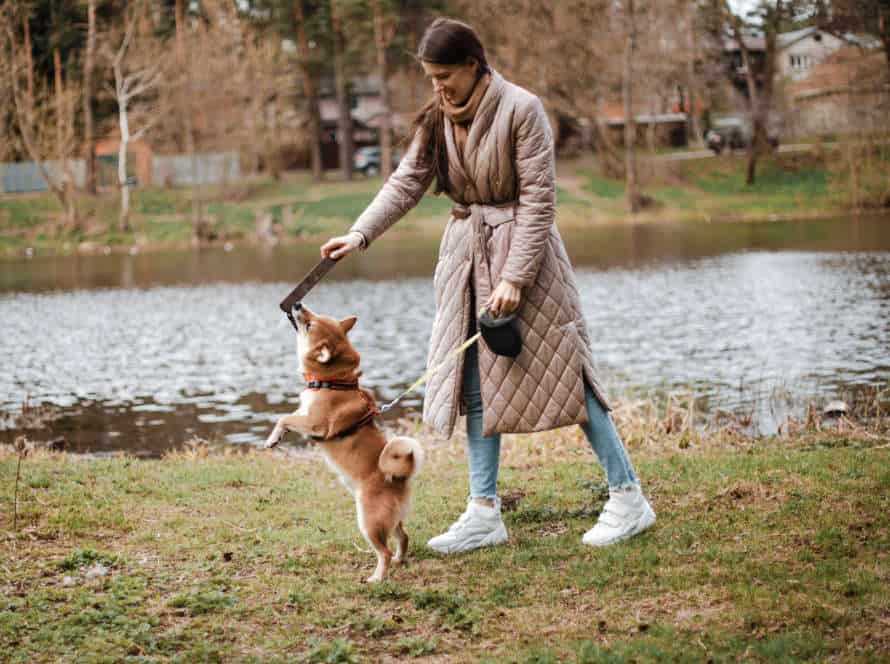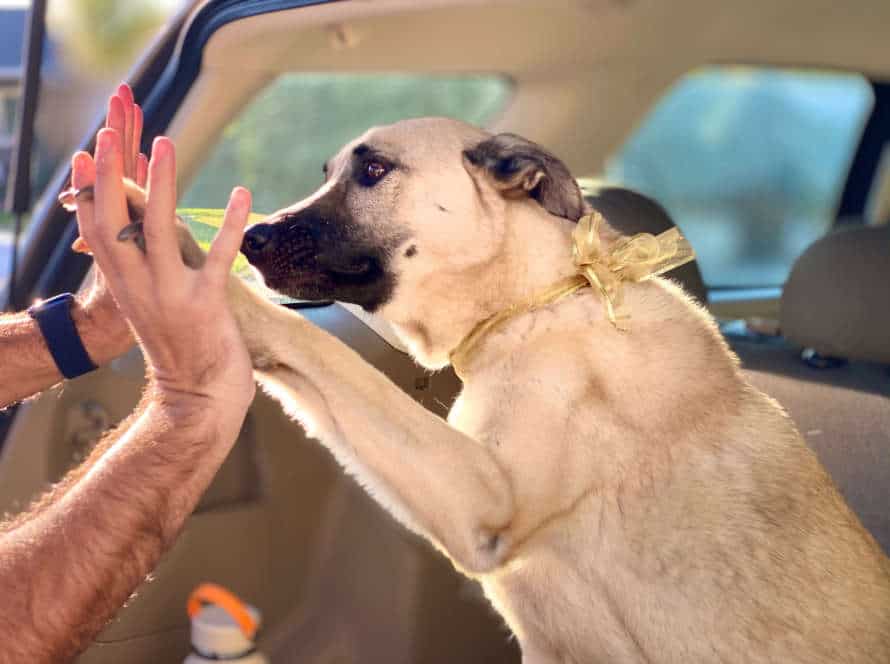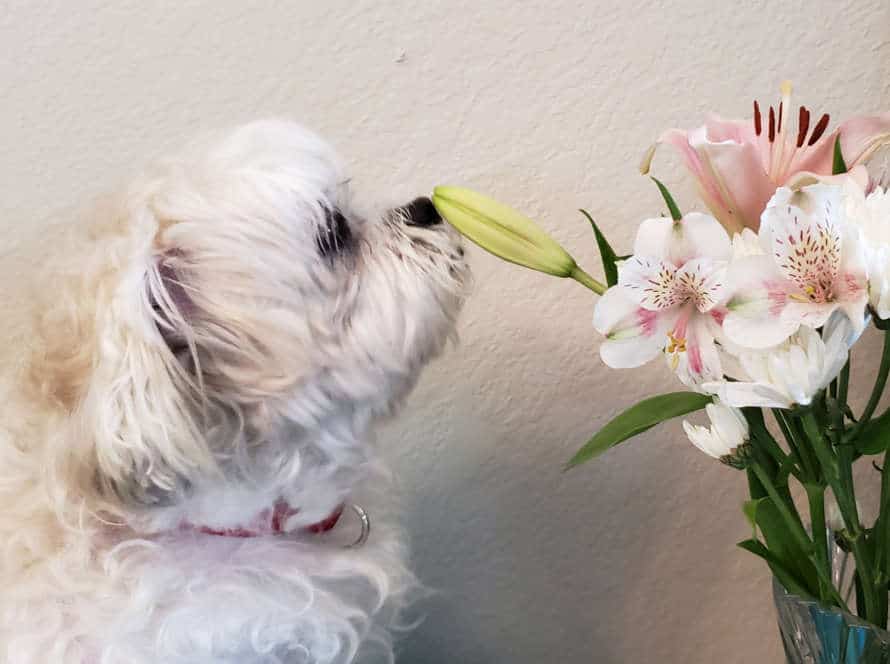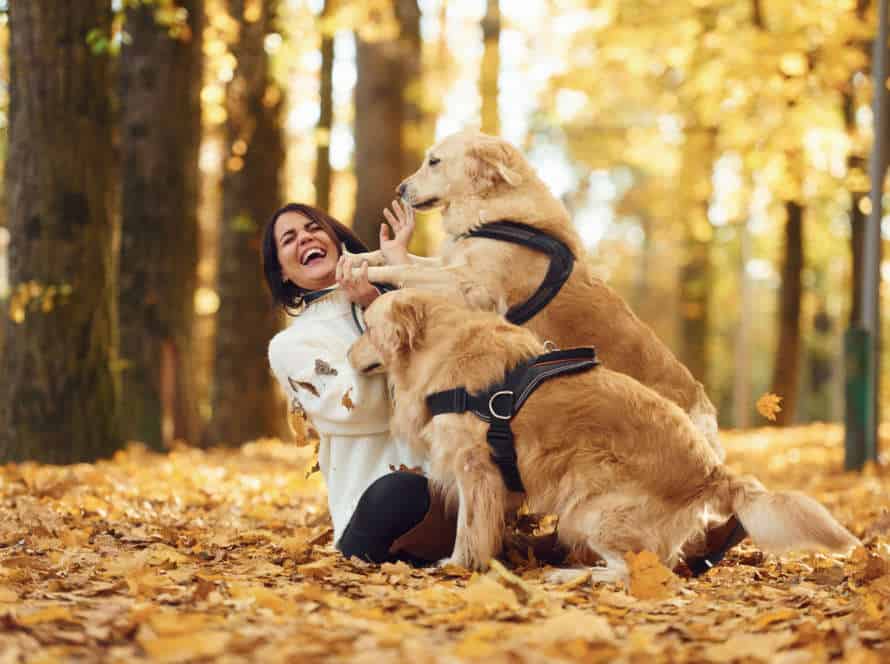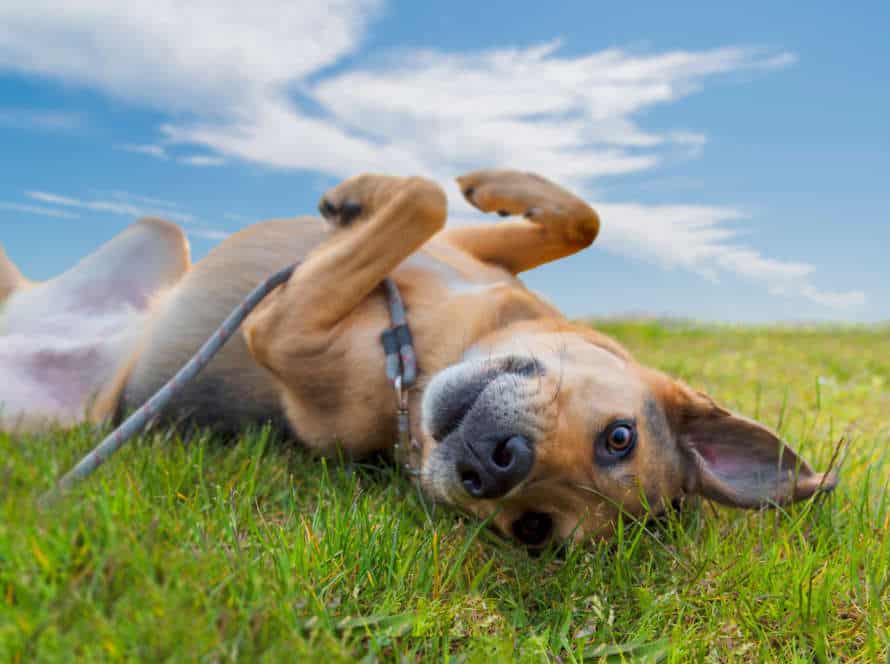Bonding with Your Senior Dog Through Trick Training
Trick training is an awesome opportunity to get closer to your elderly furry pal and keep their brains alert and occupied. Here are some pointers when trick training with aged canines:
- Keep it simple. Pick tricks that are straightforward and low-impact, such as “shake” or “spin.”
- Go slow. Senior dogs might have physical constraints, so be tolerant and take breaks as required.
- Use positive reinforcement. Reward your pup with treats and compliments for their attempts and accomplishments.
- Be consistent. Exercise regularly and make training a fun and delightful experience for your doggo.
Treat training is an incredible way to fortify the relationship between you and your mature dog while keeping them mentally enthused and physically active.
Understand the Benefits of Training Your Senior Dog
Training your senior pup has many advantages! It can help you and your pet become closer. Plus, it’ll keep them both mentally and physically active. You can even use trick training to help them stay fit and give them a reason to exist. In this article, we’ll explore all the perks of training your elderly pooch!
Enhance your dog’s mental stimulation and physical activity
Train your senior pup for both physical and mental stimulation – it’ll enhance their quality of life! And here are the perks of training a senior dog:
- Mentally stimulating – it can improve their cognitive ability and reduce anxiety and boredom.
- Physical activity – trick training is a great way to get them moving, increasing their flexibility and mobility.
- Bonding – Positive reinforcement will make your bond stronger, leading to better behavior and overall wellbeing.
Remember – start with simple training activities and progress from there. Also, make sure to reward with praise, treats, and positivity!
Improve your dog’s cognitive function
Training your senior pup with fresh tricks and orders can help boost their cognitive abilities and give them mental stimulation. It’s a great idea! Here’s why:
- It stimulates their brain – getting your doggo to learn new things helps work their mind and keeps it fit and healthy.
- It strengthens your bond – training helps you two understand each other better, so you can rely on each other more.
- Exercise – mental workouts are just as important as physical ones. Training sessions give your aging pooch a chance to move their mind without stressing their body.
- It helps manage their behaviour – teaching your pup new strategies to help them navigate changes in their life will reduce stress for both of you.
Strengthen your bond with your senior dog
Training your elderly pup is great for their physical and mental wellbeing, plus it strengthens your relationship. Trick training can be fun and rewarding for both of you.
The perks of training your senior doggo include:
- Mental stimulation – Training exercises give their brain a workout and help avoid cognitive decline.
- Physical exercise – Training helps keep them healthy and active.
- Less anxiety – Training can reduce anxiety and build confidence.
- Bonding – Training together with positive reinforcement deepens your bond.
Try some simple tricks like “shake,” “roll over,” and “spin.” Use treats and lots of praise to keep them interested and motivated. Pro tip – Check with your vet before beginning a new training routine.
Preparing for Training
Trick training could be a fantastic way to make your connection with your older pooch even closer. It’s something that you can achieve together, it encourages physical movement, and helps them stay mentally stimulated.
Prior to beginning a trick training program, it’s vital to get ready in order to ensure it’s an enjoyable and successful experience for both of you. Let’s check out how we can best prepare.
Select the right training location
Choosing the ideal training locale is super important when you’re prepping to bond with your senior pup through trick training. Here’s some advice to help you pick the perfect spot:
- Peaceful area: Locate a tranquil area, away from disturbances. Senior pooches often get sidetracked easily, so choose a place where they can only focus on you and the training exercise.
- Indoors or outdoors: Decide if you want to teach your dog indoors or outdoors, depending on the type of skill you want to teach. If it’s a trick that involves jumping, you’ll need more room outside. If it’s a trick that involves being still, it’s probably best to train your pup indoors.
- Weather: Make sure you know the weather conditions when you pick an outdoor location. Avoid training in the hot afternoon sun or in the rain.
Keep in mind, every pup learns differently, so be patient, stay positive, and savor the bonding experience with your furry bestie.
Gather Treats / Rewards for Training
Treats and rewards are great for training and bonding with your older pup. Here’s how to prepare:
- Choose their faves: chicken, cheese, or peanut butter. Break into small pieces for rewards.
- Bring their fave toys. Use them as rewards or to encourage during training.
- Clicker training? Yes please! It’s great for seniors as they can learn at their own pace and without having to exert much.
- Short, positive sessions are best. Be patient and consistent and you’ll see progress and have fun bonding.
Consider the duration and frequency of the training session
Training senior dogs? Here’s the lowdown.
- Keep it brief! Sessions should last no more than 10-15 minutes.
- Time ’em for when your pup is well-rested and alert.
- Treats, praise, and affection help keep ’em motivated.
- Take breaks to let ’em recharge.
- Adjust intensity and frequency based on age, health, and physical abilities.
- Talk to your vet first.
- The key? Patience, consistency, and positive reinforcement.
- It’ll help build a strong bond – and teach them new tricks!
Basic Tricks to Teach Your Senior Dog
Strengthen the bond between you and your pet by teaching basic tricks to your senior dog! It’s both fun and beneficial. Tricks can be simple, like ‘stay’, or more complex, like ‘shake’ or ‘jump’.
Here are some basics to get you started: teach your senior pup tricks! It’ll help keep their brain sharp and provide mental stimulation.
Teach your senior dog to “Shake”
Teaching your elderly pup to “shake” is a great way to build a bond with them through trick training. Here’s how to do it:
-
Get your dog to sit in front of you.
-
Put your palm out in front of their paw, and say “shake” while lightly tapping their leg.
-
When they lift their paw, give them a treat and show your appreciation.
-
Do this several times a day until they start raising their paw when they hear “shake”.
-
Phase out offering a treat every time they shake, to avoid over-treating.
-
Be patient – they may take longer to learn new tricks than younger dogs, but with practice, they’ll eventually be an expert!
Teach your senior dog to “Roll Over”
Teaching your senior dog to “roll over” can be a fun way to bond with them. Here’s how to get started:
- Have your pup lay down on their side next to you.
- Lure them to roll over with a treat or toy.
- When they start rolling, use a verbal cue (like “roll over” or “turn around“) and give them the treat.
- Train in short, positive sessions.
- Be patient and make sure it’s fun for your pup.
Pro Tip: Customize your approach to their individual needs. Take into account any physical limitations or other concerns.
Teach your senior dog to “Play Dead”
Teaching your senior pup to “Play Dead” can be enjoyable and rewarding! It also helps keep their brain active.
Here’s a basic method:
- Start with the “Down” command. They should already know this.
- Hold a treat just above their nose and slowly move it towards the back of their head.
- As they follow it with their nose, they’ll roll onto their side.
- Give them the treat and praise them when they’re on their side.
- Repeat this several times. They’ll understand the command “Play Dead” and be able to do it on command.
Be patient and consistent. Always reward their hard work and efforts!
Advanced Tricks to Teach Your Senior Dog
Teaching tricks to an elderly pooch is a great way to build a connection with them. It’s a fun activity to keep their brain active and help boost their self-assurance. You don’t have to stick to basic tricks either! There are many advanced ones you can teach your pup that build on the basics.
Let’s take a peek!
Teach your senior dog to “Jump through a Hoop”
Train your senior pup with a fun trick: “Jump Through A Hoop“! But first, make sure they’re fit enough to do it. Here’s how you can teach them:
- Start with a low hoop on the ground.
- Hold a treat on the other side and encourage your pup to walk through it.
- Once comfortable, hold a treat on the other side and have them jump.
- Praise your pup and give them a treat for the jump.
- Gradually raise the hoop height until your pup can jump higher.
- With daily practice, your pup can master the hoop trick and show off to friends and family!
Teach your senior dog to “Crawl”
Teaching your senior dog to “crawl” is a great way to bond and get them moving. Here’s how:
- Place a treat in front of their nose.
- Move the treat away, lowering it to the floor.
- Say “crawl” and use your free hand to guide them.
- Reward them with the treat and praise when they start crawling.
- Practice in short sessions. Increase the distance and duration gradually.
- Be patient – senior dogs may take longer to learn tricks.
Pro Tip: Trick training is fun and mentally stimulating for seniors. It boosts cognitive function, memory, and concentration, and strengthens the bond between you and your pup.
Teach your senior dog to “Spin”
Teach your senior pup to spin! It’s an amazing trick that’ll strengthen your bond. Here’s how:
- Get your dog’s favorite treat.
- Hold it near their nose & lure them in a circle.
- As soon as they complete the circle, reward & praise.
- Repeat until they spin without the treat.
- Add a hand signal or verbal cue like “spin”.
- Practice in different places & with distractions.
Be patient & positive. Always reward good behavior. Trick training is enjoyable & rewarding for you & your pup. Plus it’s mentally stimulating!
Pro tip: Skip tricks that require jumping or intense physical activity to avoid injury.
Tackling Behavioral Issues
Senior pooches can sometimes have behavioral issues due to pain or anxiety. This can make it hard to form a bond with them. Trick-training is a great way to tackle these difficulties, plus create a strong relationship with your older dog. Trick-training gets senior dogs active, thus helping to keep a healthy lifestyle. In this section, we’ll look at how to use tricks to bond with your senior pup and solve any behavioral problems.
Address Separation Anxiety through Training
Separation anxiety is a problem a lot of dogs have – especially seniors. This can be tough for both you and your pup. Training can be a big help though! Trick training is a fantastic way to bond with your senior dog and ease the separation anxiety. Here’s how to use training to do it:
- Start with basic commands – sit, stay, come, lie down.
- Progress to trick training – fetch, rollover, play dead.
- Keep the trainings short and positive – treats and praise are great rewards.
- Gradually increase the time apart – start with a few minutes and work up to longer periods.
- Ignore them for a few minutes before leaving and coming back to show them separation isn’t a huge deal.
With persistence and consistency, trick training can help your senior pup feel more secure and strengthen the bond between the two of you.
Help Correct Aggressive Behavior through Trick Training
Tackling aggression in your mature pup? Trick training can do the trick! It redirects their attention, and even helps strengthen your bond. Here are some tips to get you started:
- Keep treats in a closed fist or cupped hand and let them sniff it.
- Reward their good behaviour with short training sessions.
- Verbal tones tell them when they’re on-track or off-track.
- Go slowly, at their pace, to avoid scaring them.
- Praise them constantly for their positive progress.
Trick training is great fun, and a great way to help your senior pup overcome issues like aggression, and build a rewarding relationship between you two.
Overcoming Fear and Nervousness with Trick Training
Trick train your senior pup for the ultimate bond! Tackle their behavioral issues, like fear and nervousness. Here are some tips to get you started:
- Start small – begin with simple tricks, and progress from there. Be patient and reward progress.
- Positive reinforcement – use treats, praise, and love to show good behavior and stop bad behavior. This builds trust with your pup, and reduces fear and anxiety.
- Make it fun – Trick training should be an enjoyable experience for you and your dog. Use toys and playtime to create a happy connection with training.
Pro tip: Trick training is an awesome way to build a strong bond with your senior pup. Stay patient, use positive reinforcement, and have fun for the best results!
Final Considerations
Safety first when training your senior pup! Having fun and creating a bond is important too. Training them with tricks? Go for it! But, here are some things to consider first:
- Safety
- Fun
- Building a bond
- Tricks
Let’s take a look!
Celebrate your dog’s accomplishments
Your senior pup can still learn tricks! Celebrate their successes and strengthen your bond with these tips:
- Keep training sessions short and positive.
- Adjust difficulty to suit their abilities.
- Make it fun and stress-free.
- Use praises and rewards to encourage.
- Pat on the head and treats can go a long way in reinforcing good behavior.
Pro Tip: Record their training journey. Celebrate each milestone and look back on their progress. It’s a heartwarming reminder of the bond you share!
Know when to take a break
Knowing when to take a break is a must when bonding with your senior pup through trick training. As they age, they may tire more easily and can’t do physically demanding tricks for long. Here’re signs they need a rest:
- Heavy panting
- Not following commands
- Limping
- No interest in treats or toys
If you see any of these, stop training! Take a break, stretch, go for a short walk, massage…anything to help them rest and recuperate.
Pro Tip: Visit the vet regularly to check their health.
Continue the training even outside of the training sessions
Training your senior pup is not just for formal sessions! You must keep training outside these sessions to make sure the pooch remembers their behavior. Here are some tips to help you:
- Practice the tricks in different places, like home and the park.
- Teach them new tricks to keep it fun!
- Put the tricks into playtime to make it engaging.
- Use treats and praise to show appreciation and motivate them.
- Be consistent with your methods and expectations.
By doing this, you can keep your senior pup mentally and physically active, plus strengthen your bond. Pro tip: It’s never too late to start training them – patience, consistency, and positive reinforcement will make it enjoyable and effective.
Frequently Asked Questions
1. What kind of tricks can I teach my senior dog?
You can teach your senior dog a variety of tricks such as sitting, lying down, rolling over, shaking hands, playing dead, and many more.
2. Is it too late to teach an old dog new tricks?
No, it’s never too late to teach your senior dog new tricks. They may take longer to learn, but it’s a great way to keep them mentally and physically engaged.
3. How often should I train my senior dog?
You should aim to train your senior dog for 10-15 minutes a day, several times a day. It’s important to keep training sessions short and consistent to avoid overwhelming them.
4. Can trick training help with my senior dog’s mental health?
Yes, trick training can be a great way to improve your senior dog’s mental health by providing mental stimulation and helping them feel a sense of accomplishment.
5. What if my senior dog has mobility issues?
If your senior dog has mobility issues, you can still teach them tricks that don’t require them to move around too much such as “leave it” or “high five.” It’s important to consult with your veterinarian before starting any training program to ensure it’s safe for your senior dog.
6. Can my senior dog still have fun while training?
Absolutely! Trick training can be a fun and rewarding experience for your senior dog, and it’s a great way to strengthen your bond with them. Use positive reinforcement and reward-based training methods to help keep it enjoyable for both you and your senior dog.


